|
Battle of the Java Sea, in which Exeter was sunk
This is the report by the Captain of Exeter, covering the Battle of the Java Sea, in which Exeter was sunk, and Captain O.L.Gordon RN was taken a POW by the Japanese. He recorded the event some three weeks after the action, and hid his notes over his 3.5 years of captivity in a hollowed out shaving cream tube, and then based this despatch to the Admiralty on his long hidden notes after he was freed at the end of WW2.
The captain and his ship took part in the Battle of the River Plate.
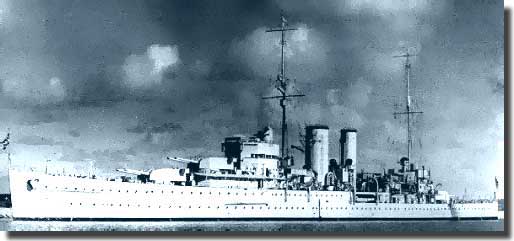
HMS Exeter (more pictures at the bottom of the page)
Battle of the Java Sea
APPENDIX.
The following Despatch was submitted to the Lords Commissioners of the Admiralty on the ist October, 1945, by Captain O. L.
GORDON, M.V.O., R.N.
U.S.S. GOSPER.
At sea.
1st October, 1945.
I have the honour to submit the following report on the circumstances and actions which occurred between 25th February, 1942, and 1st March, 1942, culminating in the loss of H.M.S. EXETER under my command on the latter date. More than three and a half years has elapsed since the events covered by this report took place, but the essential points were, recorded within three weeks of that time and have been most carefully preserved throughout my captivity by such devices as concealment in a large empty shaving cream tube and similar subterfuges, causing me considerable concern during frequent searches by the Japanese.
2. Since all records were lost when H.M.S. EXETER was sunk, detailed accuracy in such matters as times, courses, etc., cannot be guaranteed but I am confident that the report gives as accurate a picture as it is possible to present in such circumstances. All times given are zone — 7.5.
3. In accordance with orders received from the Commodore Commanding China Force (C.C.C.F.), EXETER with PERTH, ELECTRA, JUPITER, and ENCOUNTER in company sailed from Batavia at 1600, 25th February, 1942, for Sourabaya, with instructions that on arrival this force was to be under the orders of Rear Admiral Doorman, Eskadier Commandant (E.C.). The passage was without incident except for the location by radar of a large formation of enemy aircraft heading for Sourabaya, which information was passed to Sourabaya by signal.
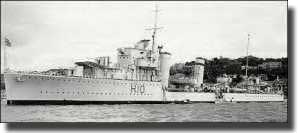
HMS Encounter, also sunk with HMS Exeter, at the Battle of the Java Sea.
4. On arrival at the entrance to Sourabaya minefields at about 1230/26, destroyers under the orders of ELECTRA were ordered to proceed ahead and on arrival to pass a fuel requirement signal to E.C. ELECTRA and EXETER embarked pilots inside the minefields and the latter with PERTH in company anchored at Sourabaya at about 1600.
5. Instructions were received, for ships to be ready to sail at 1800, which prohibited cruiser's from completing with fuel since no oilers were available and time was insufficient to proceed to oiling berths inside a basin. Destroyers also experienced difficulty in obtaining fuel but all eventually fuelled though some were unable to complete to full stowage.
6. Rear Admiral Doorman had called a meeting of Commanding Officers for 1700 but no information of this was received until nearly that time when the British Liaison Officer attached to DE RUYTER arrived OIL board EXETER. As a result the Commanding Officer of PERTH and myself were very late in joining this meeting, and only arrived at the risk of our lives in trie fastest and most dangerous motor car ride through traffic that we had ever experienced.
7. The instructions at this meeting were necessarily brief and consisted only in Rear Admiral Doorman's intentions regarding: —
(a) Order of leaving harbour.
(b) Cruising formation and destroyer screening.
(c) Patrol area and movements to cover this area to best advantage, based on meagre information available of a large enemy convoy Southwest of the Celebes and steering in a South westerly direction.
(d) Method of attack if enemy forces, and in particular an enemy convoy, were met.
(e) Subsequent destination in the absence of other information—
(i) If no enemy were sighted,
(ii) If action was joined and ships or units-became separated.
(f) Night Recognition Signals.
8. The Allied force consisted of: —
Cruisers:
DE RUYTER (Flag),
EXETER,
HOUSTON,
PERTH,
JAVA,
in the order of ships as formed at sea.
Destroyers:
British—ELECTRA (Commander May), JUPITER, ENCOUNTER;
American—JOHN D. EDWARDS (Commander Binford), ALDEN, PAUL JONES, JOHN D. FORD;
Dutch—DE WITT, KORTENAER.
9. This force sailed from Sourabaya at 1906/26. After clearing the minefields the force assumed the cruising order previously arranged, namely, cruisers in single line, British and Dutch destroyers screening ahead, and U.S. destroyers forming a separate unit astern. Rear Admiral Doorman's reason for stationing the U.S. destroyers astern was due to their inferior gun and superior torpedo armament. The cruising order of the force was in reality designed for a night encounter with an enemy convoy, when it was the Admiral's intention that cruisers and British and Dutch destroyers should engage enemy escort forces, at the same time endeavouring to circle the convoy, while the primary duty of the U.S. destroyers was to sink the troop ships comprising the convoy. Course was first set to the Eastward (085 degrees) to intercept any attempted landing on Madura Island and was reversed at 0100/27 top 270 degrees.
10. The night of 26th/27th passed without incident, the EXETER being at the first degree of readiness throughout. Shortly after daylight enemy reconnaissance aircraft located the force and during the forenoon minor bombing attacks were experienced, mostly by single aircraft, and without damage to the Allied force. At about 1030/27, when some 60 odd miles to the Westward of Sourabaya, course was reversed and the Admiral signalled his intention, in the absence of further information, of anchoring inside the minefields off Sourabaya and repeating the previous patrol that night.
11. At about 1415 when the Allied force was entering the minefields through the Western channel, the Admiral led round 180 degrees and signalled that information had been received of an enemy force of two cruisers and six destroyers some 90 miles to the Northward steering South at high speed, which force he intended to engage. Later reports showed that the large enemy convoy previously referred to was remaining in position some 10 miles West of Bawean Island.
12. The Allied force, still retaining the previous cruising order, steered 350 degrees at 20 knots to intercept.
13. At approximately 1610 masts were sighted to the Northward. These proved to be two four-funnel Sendai class cruisers, each leading a flotilla (or division) of six Asashio type destroyers. At'this time these were the only enemy .ships in sight. Speed was increased until subsequently the action was fought at about 27 knots.
14. Weather conditions were:—wind N.E. force 1-2, sea 1, one tenth cloud, visibility extreme.
15. At about 1620 the leading cruiser opened fire apparently at ELECTRA, the starboard wing destroyer of our screen. The main armament reporting that this cruiser was now within gun range, EXETER opened fire at approximately 27,000 yards, this being outside DE RUYTER's extreme range. After some 12 salvos from A and B turrets had been fired, when it appeared that straddle range had been obtained, the target cruiser turned away under smoke. Fire was then shifted to the second four-funnel cruiser. It was about this time, or shortly before, that further masts were sighted to the N.N.E. and some distance in rear of the cruisers and destroyers previously referred to. These proved to belong to two cruisers of the Ashigara or Atago classes. The above mentioned enemy ships, namely, two Ashigara or Atago class cruisers, two Sendai class cruisers, and 12 Asashio class destroyers composed the enemy force during daylight on 27th February as far as could be seen from EXETER, although officers from HOUSTON and PERTH subsequently stated that six or more enemy cruisers were present.
16. The second four-funnel cruiser engaged turned away under smoke after about 10 salvos and was momentarily re-engaged when again seen clear of her own smoke after having made a turn of some 180 degrees. The hitting range of this cruiser was quickly found and I am convinced that hits were obtained, particularly as she was last seen disappearing in a thick high column of smoke and only one four-funnel cruiser was seen subsequently.
17. Target was then shifted to the rear (right hand) of the two 8-inch cruisers previously referred to. The reason for selection of the rear and not the leading cruiser was the fact that HOUSTON next astern of EXETER, was already engaging the leading cruiser and, in view of the difficulties of signalling together with the time that would be lost during the change' over, it was considered better to accept the situation as it was found and engage the right-hand ship although this meant crossing fire with HOUSTON.
18. At first difficulty was experienced in identifying our own splashes until it was realised that HOUSTON was using brown splashes. Fire was opened at extreme range and the first splashes were not seen. This together with difficulties already referred to, made it some time before range was established, in all about
15 salvos. Shortly after this a hit was observed by myself, other officers on the bridge and several members of the Director Control Tower's crew including the Gunnery Officer, in the vicinity of her lower bridge structure. Almost immediately afterwards she turned away under smoke.
19. While engaging this cruiser it appeared that the enemy fire was concentrated on EXETER who was eventually straddled and sustained either a hit or a near miss underwater well aft. This had the apparent effect of lifting the whole ship in a most remarkable manner. Subsequently some after underwater compartments were found to be flooded. A few minutes later a shell, passing through S.2 four inch gun shield, entered B boiler room causing casualties at S.2 mounting and in this boiler room. The opinion was formed on subsequent examination that this shell did not detonate but exploded on entering a boiler, since the baseplate complete and a large portion of the nose were recovered. (Similar failure of some enemy shells to detonate was experienced by other Allied ships.) Six out of the eight boilers were put out of- action with the following main results: —
(i) Deafening escape of steam through the waste steam pipe.
(ii) Initial reduction of speed to 11 knots with a subsequent maximum of 15 to 16 knots.
(iii) Temporary failure of the High Power system putting the main armament out of action.
20. EXETER started to haul out of the line gradually to port simultaneously with the development of a torpedo attack by the enemy destroyers led by the one remaining four-funnel cruiser. The Admiral now led round to port to an approximately reciprocal course presumably as an avoiding action. The remaining cruisers of the Allied squadron turned short and reformed astern of the Admiral. At this point ELECTRA made a lone and very gallant counter-attack, JUPITER and ENCOUNTER also engaging enemy destroyers while covering EXETER's turn by smoke. Later information indicated that ELECTRA was last seen stopped and still in action with enemy destroyers. It is believed that the attacking destroyers fired their torpedoes at a range of about 8 to 10,00 yards. Torpedoes were seen approaching, one exploding in the water and another hitting and blowing up the Dutch destroyer KORTENAER, whose back was broken and who remained afloat for some minutes with bow and stern only showing. It was during this period that EXETER's main armament was lined up and made ready for action.
21. While the enemy torpedo attack was developing and after EXETER had turned “to a Southerly course, the main armament" engaged the four-funnel cruiser leading the attack, the four-inch armament also being engaged' with enemy destroyers. This cruiser turned away under smoke immediately straddle range was found and the results of our fire could not be observed. Shortly after this a single enemy destroyer offered a favourable target through the smoke at 9,000 yards, but fire had to be withheld as" our own destroyers were in the line of fire.
22. When DE RUYTER passed ahead after reversing course, the Admiral enquired by signal as to damage sustained and was informed that, as the result of a boiler room hit, speed was reduced to a maximum of 15 knots, this reply being repeated to PERTH. The Admiral then ordered EXETER to proceed to Sourabaya.
23. Shortly after this, when EXETER had dropped considerably astern, a single enemy 8-inch cruiser was seen to the Northward and fine on the port quarter closing EXETER. Fire was at once opened with Y turret and course altered to open "A" arcs.1 The range was about 16,000 yards and after a few salvos the enemy turned away to the Northwards under smoke.
24. By this time the remainder of the Allied squadron, which, with the exception of the KORTENAER, appeared to have suffered little if any damage, was steering to the Eastward firing intermittently and EXETER gradually shaped course for Sourabaya. Light was failing and the time must have been about 1830. When almost dark the Dutch destroyer DE WITT, then about 5 miles to the Eastward, signalled on shaded lamp that she would lead EXETER through the Sourabaya minefields. The only other incident during the return to Sourabaya was the sighting of star shell some distance away to the Northwest. EXETER anchored in Sourabaya roads just before midnight and proceeded to a berth alongside at the Naval Base at 0700/28.
25. The following are general remarks on the action: —
(i) The total period that EXETER was in action was about two hours, but a detailed timetable of events cannot be given since all records were lost when the ship was sunk on ist March. As a result, this report may tend to give a misleading conception of the interval between the various episodes of the action, e.g., between being hit in B 'boiler room and engaging the four-funnel cruiser leading the torpedo attack, there was sufficient time to restore the High Power, check main armament receivers and verify ammunition remaining.
(ii) This action demonstrated in a very marked manner the difficulty of working with a heterogeneous squadron, composed of ships of different nationalities, all of whose methods, but in particular those of signalling and fire distribution, differ from our own and with whom there had been no opportunity of even the briefest discussion on such matters.
(iii) It was clear that the Dutch cruisers were outranged for most of the daylight action and their splashes only made spotting more difficult for the remainder.
(iv) The enemy made use of a number of spotting aircraft; these were engaged as
(v) During the action an attack was made on the enemy cruisers by land-based bombers from Sourabaya, and several bomb splashes were observed. The enemy appeared to be unaffected by this attack. About the time that the Allied squadron reversed course and when the enemy torpedo attack had developed, the four American destroyers previously stationed astern fired torpedoes. It was not clear what was their target but the majority of these torpedoes were seen to be running on the surface in the direction of the Japanese destroyers.
26. Enemy air raids were continuous throughout daylight of 28th February. The funeral of those killed in action took place with full naval honours at 1700, every assistance being given by the Dutch Navy, all local naval authorities being represented.
27. Results of action. Four-funnel Sendai class cruiser referred to in para. 16.
(a) Some survivors of HOUSTON and PERTH stated that an enemy cruiser, believed to have been, under fire from EXETER, was seen to sink stern first. It is possible that this may have been the cruiser referred to in para. 16. ,
(b) .While at Macassar P.O.W. Camp the Navigating Officer of the first Sendai class cruiser engaged by EXETER visited the camp. He was friendly and spoke good English. In the course of conversation he stated that while his ship had not .been hit, EXETER's splashes had been so close that water from them fell on the bridge. When asked what happened to the second 6-inch cruiser he did not reply and quickly changed the subject.
8-inch cruisers.
(a) As stated in para. 18 this cruiser was seen to have been hit and only one 8-inch cruiser was sighted from EXETER during the remainder of the day action.
(b) After return to Sourabaya information was received that aircraft had reported a Japanese 8-inch cruiser on fire.
Other reports.
According to surviving officers of HOUSTON and PERTH hits were obtained by HOUSTON on the leading enemy 8-inch cruiser, and an enemy destroyer was sunk during the torpedo attack.
28. EXETER sailed from Sourabaya at 1900, 28th February, 1942, in compliance with a signal received from C.C.C.F., which directed EXETER, ENCOUNTER and POPE to sail at dark proceeding as follows: —
20 miles to the Eastward from Sourabaya Northern entrance, thence Northward to pass Eastward of Bawean Island, thence Northwestward and Westward and through Sunda Strait to Colombo.i
29. The Netherlands destroyer DE WITT was also directed at the last minute to accompany me. When I sailed it was understood that she would follow at about 2100 joining me shortly after midnight. Anticipated courses and speeds were accordingly given to the Navigating Officer of DE WITT, but she did not join and no information was received as to whether or not she ever left Sourabaya.
30. By 1500/28 from examination it appeared probable that two boilers in B boiler room could be got ready for steaming by about 2300/28, but that satisfactory performance of these boilers would be dependent on power trial at sea. Rear Admiral Palliser 2 was informed accordingly by telephone from Dutch Naval Headquarters. With two boilers EXETER's maximum speed was 15 to 16 knots; with four boilers it was hoped to obtain 24 knots, but 23 knots was the maximum that could be maintained subsequently.
31. The first part of the night 28th February/1st March' passed without incident. Weather conditions were as follows:—wind E.N.E., force 2, sea 20, cloud two tenths, full moon. After clearing Sourabaya minefields the destroyers were ordered tn take up screening diagram Number 2A and shortly before midnight steam was available in the two additional boilers. Speed was increased by steps to 23 knots, the maximum capacity of the four boilers. It may be well to remark here that all four serviceable boilers were on the starboard side, two in each boiler room. No unit system was possible and all four boilers had therefore to be cross connected. Course was altered to ooo degrees at midnight to pass some 25 miles East of Bawean Island and at 0200 to 345 degrees.
32. It had been intended to alter course to 290 degrees at 0400, but shortly before this, three ships, two large and one smaller, were sighted to the Westward in the light of the setting moon, distant about 10 miles, steering to the S.S.W., to pass Westward of Bawean Island. These appeared to be two merchant ships escorted by a cruiser or destroyer. From my orders and routeing I had no doubt in my mind that my object was evasion in this attempt to clear the Java Sea, and accordingly I turned away stern on to avoid being sighted, then worked round to the Northward and resumed course 345 degrees at about 0430. Subsequently course was altered to 290 degrees at 0600 and 280 degrees at 0700. No enemy air or surface forces were sighted at daylight and visibility was extreme.
33. At about 0750 the crow's nest lookout reported the masts of two ships nearly right ahead. These were identified as the topmasts of warships, cruisers or larger, steering to the N.N.E. Course was immediately reversed and it was thought possible that, with the advantage of light, EXETER had not been sighted. This hope was short lived as the enemy ships were seen to turn towards though still well hull down. An enemy report was therefore made and repeated but no acknowledgment was received. This turn towards by the enemy cruisers was brief and may' possibly have been for the purpose of flying off aircraft, as they resumed their Northerly course and were soon out of sight. EXETER worked gradually to the Southward and Westward through East finally steering 260 degrees. In spite of failure to receive acknowledgment of the enemy report I decided against further repetition, since avoidance of disclosure of movements by D/F3 seemed of greater importance than any possible advantage to be gained by continuing to make this report. For some time it appeared that evasion had been achieved since no enemy forces were sighted, although it was subsequently stated by the Japanese that their cruisers, as these ships proved to .be, had flown off reconnaissance aircraft. There was however no indication of this on the radar screen nor was any aircraft sighted until action was subsequently joined.
34. It was not until about 0935 that the topmasts of 'two large cruisers were sighted bearing about 170 degrees steering to the Westward. Course was immediately altered to 320 degrees with a view to possible evasion, but these cruisers also were seen to turn towards. Very shortly after this an enemy ship, at first thought to be a 6-inch gun cruiser, was sighted ahead steering directly towards. This ship proved to be a large destroyer. It was engaged by EXETER and destroyers at ranges between 20,000 and 14,000 yards, but on being engaged turned away to the Westward under smoke. Almost simultaneously two more large cruisers were sighted bearing approximately 330 degrees and these at once turned towards. All four cruisers proved to be ten-gun 8-inch cruisers of the Ashigara or Atago classes and one is believed to have been the flagship ASHIGARA. Course was immediately altered to the Eastward (090 degrees), destroyers conforming.
35. EXETER's speed at this time was 23 knots on four out of the eight boilers, but shortly afterwards the Engineer Officer reported that he believed that steam could be raised in one more boiler in B boiler -room, and this boiler could be connected in about an hour. Orders were given for this to be done and the extra boiler was connected in less than that time. From then (about 1055) a speed of 25 knots was maintained and before the end the ship was steaming at 26 knots. This and the repair work after the action on 27th February reflects much credit on the Engine Room Department.
36. The enemy cruisers to' the Northwest were the first to open fire at long range, their fire being immediately, returned by EXETER. It was most unfortunate that at the start of this action the fire control table was damaged and put out of action by a failure in the enemy travel drive. Until this damage was realised salvos fell appreciably out for line and during the remainder of the action a clock and Dumaresq had to be used while repairs were attempted.
37. An enemy report was made when it was seen that evasion was no longer possible and two other reports were made subsequently during the action.
38. The ensuing action is difficult to describe in detail with no records available. The general trend of the action was Easterly with course varying between about 070 -degrees and no degrees as alterations were made to avoid straddling or to open " A " arcs. The enemy cruisers were disposed -in pairs, one pair approximately abeam to starboard and the other on the port quarter. They closed gradually to a range of about 18,000 yards and then appeared to maintain this distance. Later live destroyers (Asashio class), which had not been in sight when action was joined, appeared from the Southwest and drew ahead, passing on the starboard beam at a range of about 14,000 yards shortly before EXETER was hit in A boiler room.
39. About the time that the enemy cruisers found the range, POPE made smoke without receiving an order to do so. ENCOUNTER followed suit and, conditions for smoke being good, the resulting smoke screens were decidedly effective. Firing on both sides was necessarily intermittent, targets being engaged by EXETER whenever seen clear of smoke, and it was seldom that it was possible to spot on more than four to five salvos.
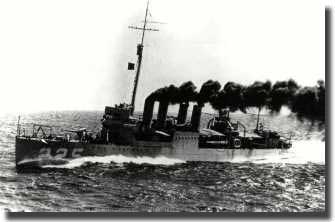
USS Pope, an old four stack destroyer,
another casualty of the Battle of the Java Sea.
40. A review of the situation at about 1100 was not encouraging. It was known that no support from surface forces could be expected, and it was believed that the Allied air forces would be fully employed against the Japanese invaders. EXETER's maximum speed was
25 knots with about 20 per cent, of main armament ammunition remaining. ENCOUNTER had fired all torpedoes in the action on 27th February. Consideration was given to a reversal of course, but no advantage could be seen, while such action would have given the enemy cruisers and destroyers a very decided position of torpedo advantage. I considered that the best policy was to continue to the Eastward and to conserve ammunition by continuing to engage the enemy on either side when clear of smoke in the hope of inducing the odds by crippling one or more of the enemy cruisers. About this time two slight rain squalls to the Eastward gave rise to the hope that others of greater intensity might be met and used to advantage. This was not the case, but POPE did make use of rain squalls later, after EXETER and ENCOUNTER had been sunk,' in her endeavour to work round to the North and West.
41. The action continued much as previously described. Neither EXETER nor destroyers had yet been hit but now, despite the use of smoke (from funnel and smoke floats), salvos were falling close and snaking was necessary to avoid being hit. At one time it was seen that a number of EXETER's salvos straddled the leading enemy cruiser on the starboard beam, but with smoke interference it was impossible to say if hits were obtained. A torpedo target at long range was presented by the two enemy cruisers on the port quarter at about 1100. As the enemy were making no attempt to close the range and so provide a better target, the port tubes were fired. No hits were obtained, the target ships taking avoiding action by alteration of course.
42. The five enemy destroyers were by this time nearly abeam to starboard and just within effective range of EXETER's four-inch armament, which .engaged them, as did the 8-inch armament when other targets were obscured by smoke." ENCOUNTER arid POPE engaged the two leading destroyers. EXETER engaged the third destroyer which was hit and dropped out of line.
43. Throughout the action the enemy had spotting aircraft up consisting of single float seaplanes and one large type monoplane was also seen. These were engaged by EXETER's A.A. armament as opportunity offered.
44. It was at about 1120 that EXETER received a vital hit in A boiler room which started a large fire necessitating immediate and complete evacuation of this boiler room. Steam pressure dropped rapidly to 170 Ibs./sq. in. and then more slowly until the main engines had to be stopped. All power in the ship failed shortly afterwards, and with it the whole of the main armament and also the secondary armament control.
45. It was at this time, as EXETER was losing way and ENCOUNTER and POPE drew ahead, that the enemy fire became really effective. EXETER was being repeatedly straddled and hit. To sum up, the situation was as follows: i—
(a) Main engines stopped and all power in-the ship failed or failing (one dynamo was kept running until steam also failed to this).
(b) Main armament and control out of action.
(c) Secondary armament control out of action.
(d) "A" boiler room on fire, with the after bulkhead of the four-inch magazine situated four feet from this boiler room necessitating the flooding of this magazine.
(e) Port torpedo tubes fired and no target available for starboard tubes.
(f) Fire had broken out in the officers' quarters aft.
(g) Enemy cruisers straddling and hitting from long range and enemy destroyers drawing ahead and now barely within secondary armament range.
46. There was now no possibility of saving the ship, and to ensure that she should not fall into the hands of the enemy the order was given to sink the ship and a few minutes later (estimated at about 1135), to abandon ship. This was carried out in an orderly manner but, with the failure of power, no boom boats could be got out. All rafts, float-a-nets and available woodwork were thrown overboard and good use was subsequently made of these. As a result of her final speed of 26 knots the ship still had slight headway when abandoned and without doubt this was instrumental in reducing casualties, since the water around the ship was alive with splashes from the enemy gunfire. The ship was evidently leaking oil fuel considerably, which, with a slight lop, made conditions in the water decidedly unpleasant at first.
47. About the time that abandoning was completed, the ship, which had' already settled appreciably with a list to port, heeled further to port to a considerable angle. Some ten minutes later a very heavy explosion was observed starboard side amidships, the column of water from this explosion being (higher (than the masts. This is believed to have been the result of a torpedo hit, probably fired by an enemy destroyer. The ship quickly righted, rolled over to starboard and sank at about 1150 in some 30 fathoms in very approximate position 64 degrees 38 minutes South, 112 degrees 28 minutes East.
48. When EXETER was hit and started to Jose way ENCOUNTER and POPE drew rapidly ahead, still engaging the enemy destroyers. They had ceased making smoke and when last seen were a considerable distance ahead. No report from the , Commanding Officer of U.S.S. POPE is available, but in conversation with him I understood that 'his ship was chased by the enemy cruisers but drew away from them taking advantage of rain squalls. He endeavoured to work round to the North and West until repeatedly attacked by high level and dive bombers, which latter eventually succeeded in putting the ship out of action, necessitating her abandonment at about 1330.
49. Throughout this final action both ENCOUNTER and POPE were well handled and well fought. Their effective smoke laying was undoubtedly of great value.
50. Some 400 survivors of EXETER were picked up after about one hour in the water by two Japanese destroyers, which then left the scene of the action on an Easterly course The remaining survivors were indeed fortunate to be picked up after about 24 hours in the water by a Japanese destroyer working in company with a cruiser or cruisers, the majority of survivors being subsequently transferred to the Dutch hospital ship OP-TEN-NOORT, then in Japanese hands. Three days later this ship proceeded to Macassar where all prisoners on board her were transferred on loth March to the Dutch military barracks which had been turned into a P.O.W. camp.
51. General Remarks.
(i) No signals were intercepted from PERTH or HOUSTON to indicate the presence of Japanese surface forces in the vicinity of Sunda Strait, nor was any information concerning enemy forces received after sailing from Sourabaya p.m. 28th February.
(ii) As stated in para. 33 no acknowledgment was obtained of the enemy report made and repeated about 0800/1. The following extract from a note written after release from Japan by the C.P.O. Telegraphist in charge of EXETER's W/T Department, may throw some light on the difficulties of enemy reporting in this area at this time.
“Four messages were transmitted, after being coded, by the P.O. Telegraphist in the Remote Control Office on the wave frequency used by ship to shore, H.M.S. ANKING and an Australian station (name uncertain but may have been Port Moresby, I cannot recall). No receipt was received from the above station who was calling H.M.S. ANKING, the W/T guardship at Batavia, who had proceeded to sea thus taking away the link with Batavia. Remote Control Office reported " No receipt " so the last two messages were also broadcast on the Indian Ocean station wave on the " I " method wave frequency used by Colombo, Bombay and Aden. We abandoned ship immediately after their transmission but it is almost certain tihat they were received by one of the three stations."
52. Results of action.
(i) Destroyer mentioned in para. 34.—The Gunnery Officer of U.S.S. POPE, which was stationed on the starboard bow of EXETER, informed me that on board POPE they felt certain that this enemy destroyer was hit. This was not seen in EXETER as the destroyer was enveloped in smoke but POPE was in a better position to see after the enemy's turn away under smoke.
(ii) Destroyer mentioned in para. 42.—The hit on this destroyer was made by EXETER's main armament. Her ultimate fate was not seen because of smoke, but a Japanese officer subsequently stated that this destroyer's stern was iblown off killing 70 men.
(iii) Damage to enemy aircraft—From a statement by a Japanese officer on board one of the cruisers to which survivors were initially transferred, EXETER's A.A. armament shot down one aircraft and damaged another. The latter with tail damage was shown to the Director Gunner of EXETER.
It is understood that both ENCOUNTER and POPE claimed hits on the enemy destroyers but no doubt these will be made in their separate reports.
(Signed) O. L. GORDON,
Captain, R.N.
Admiralty footnote :—
1 "A" arcs—the arcs on which all guns of a ship's main armament will bear, thus allowing them to fire simultaneously at the enemy opportunity presented. It was unfortunate that EXETER's Walrus aircraft was unserviceable as the result of blast damage sustained during frequent enemy air attacks.
2 Rear Admiral A. F E. Palliser was Chief of Staff to Vice Admiral Helfrich
3 D/F—direction finding
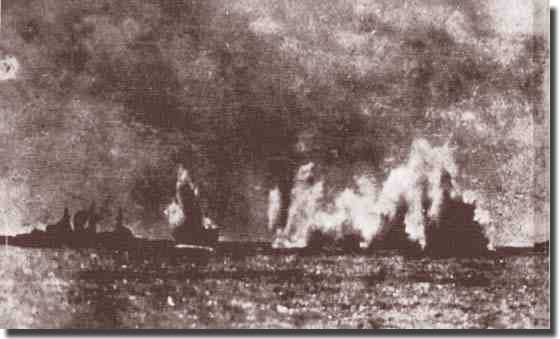
A Japanese photograph. Exeter straddled by fire from Japanese cruisers Nachi and Haguro
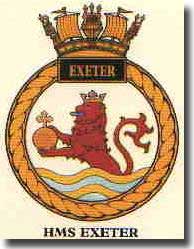
Crest of HMS Exeter
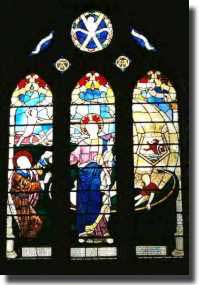
Window in Exeter Cathedral dedicated to HMS Exeter,
and her crew lost at the Battle of the Java Sea.
|
|
|






